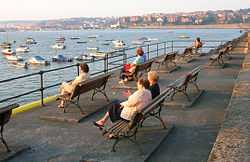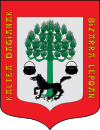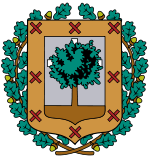Getxo
| Getxo | ||
|---|---|---|
| Municipality | ||
 | ||
| ||
|
Motto: Kaltea Dagianak Bizarra Lepoan ("He who makes evil, the beard at his back") | ||
|
Location of Getxo in Biscay | ||
 Getxo Location in Spain | ||
| Coordinates: 43°20′39″N 3°0′23″W / 43.34417°N 3.00639°WCoordinates: 43°20′39″N 3°0′23″W / 43.34417°N 3.00639°W | ||
| Country |
| |
| Autonomous community |
| |
| Province | Biscay | |
| Comarca | Uribe | |
| Judicial district | Guecho | |
| Districts | Algorta, Las Arenas, Neguri, Romo and Santa Maria de Getxo | |
| Founded | 1075 | |
| Government | ||
| • Alcalde | Imanol Landa (2007) (PNV) | |
| Area | ||
| • Total | 11.89 km2 (4.59 sq mi) | |
| Elevation | 50 m (160 ft) | |
| Population (2008) | ||
| • Total | 81,260 | |
| • Density | 6,800/km2 (18,000/sq mi) | |
| Demonym | Getxotarra | |
| Time zone | CET (UTC+1) | |
| • Summer (DST) | CEST (UTC+2) | |
| Postal code | 48991 - 48993 - 48990 - 48930 | |
| Website | Official website | |
Getxo is a town located in the province of Biscay, in the autonomous community of the Basque Country, in the north of Spain. It is part of Greater Bilbao and Uribe, and has about 83,000 inhabitants. Getxo is mostly an affluent residential area, as well as being the third largest municipality of Biscay.
History
Getxo (formerly spelt Guecho) was a parish (elizatea, anteiglesia'), originally a rural area, including a large beach at the mouth of the Estuary of Bilbao, centered on the little fishing village of Algorta. The parish council met at the church of Getxoko Andra Mari (Basque) or Santa María de Getxo (Spanish) (both mean Our Lady of Getxo), not far from the headland called Punta Galea.
The town's coat of arms has an oak with two cauldrons chained to its branches and the motto Kaltea Dagianak Bizarra Lepoan (Basque for "Who makes evil, the beard at the back").
With industrialisation in the 19th century, some parts of Getxo evolved into residential areas for the rich bourgeois class. A residential area called Neguri (Basque for "Winter Town") came into being. The village of Algorta grew around the church of San Nicolás and the canalisation of the firth, provided for the colonisation of the beach, where a district called Areeta in Basque and Las Arenas (Spanish for "The Sands") was built. Near Areeta / Las Arenas, on the other side of the road to Bilbao, there grew a working-class district called Erromo, similar to the one that grew near Neguri: Neguri Langile. Finally, in the 20th century, urban development reached the rural areas of Getxoko Andra Mari.
Getxo, as well as the surrounding area known as Uribe-Kosta, grew rapidly in the last decades of the 20th century. While in the early 80s the town had only 50,000 inhabitants, it has now more than 83,000. The surrounding towns of Leioa, Berango and Sopelana have also seen multiplied their population in the same period.
Getxo was hit by the Basque Conflict several times, with the town being the location of many ETA attacks. The deadliest of these was an ambush in October 1978 when three civil guards were killed and the most recent the car bomb attack on May 19, 2008.[1] Many activists of the organisation have been born in Getxo, such as Arkaitz Goikoetxea.
Geography
It is located 14 km of Bilbao, in the province and historical Territory of Biscay, in the community of the Basque Country, in the north of Spain. It has a surface of 11.64 km². It borders in the north with Sopelana, in the east with Berango and Lejona, in the south with Portugalete and in the west with the Bay of the Cove.
Administration

Getxo's office of Mayor has been continuously in the hands of the Basque Nationalist Party (EAJ-PNV) since democracy was restored in 1978 (Local Elections). Since 1991, the major opposition party has been the Partido Popular(PP). Other parties represented on the Town Council are the Socialist Party of Euskadi (PSE-EE) and the United Left (IU).
| Political party | Votes | % votes | town councillors |
|---|---|---|---|
| EAJ-PNV | 14 182 | 32,92% | 10 |
| PP | 12 978 | 30,13% | 9 |
| Bildu | 7 048 | 16,36% | 4 |
| PSE-EE | 4 170 | 9,68% | 2 |
| IU | 1 067 | 2,48% | 0 |
Getxo has five different districts, which serve administrative and electoral purposes: Algorta, Las Arenas, Romo, Santa María de Getxo and Neguri.
Transport and Tourism

It is possible to travel to Getxo from Bilbao using the city's modern underground Metro system, which has already 6 stations in the town (Areeta, Gobela, Neguri, Aiboa, Algorta and Bideazabal), and another one under construction (Ibarbengoa-Getxo). Getxo is also accessible from Portugalete, by means of both the Vizcaya Bridge transporter bridge and the regular fluvial transport over the Estuary of Bilbao. The ferry Pride of Bilbao reaches Portsmouth from Getxo's neighbour Santurtzi, and Bilbao Airport is also not far away in Loiu.
Getxo has some tourist appeal with easy access to several beaches, and to the regional economic capital of Bilbao. It has a yacht harbour, a golf course, and several sports complexes (both public and private). A dynamic, semi-autonomous Department of Culture organises many events on a regular basis, including several international music festivals given over to jazz, the blues and folk.
The town has many houses of architectural interest, including the Town Hall and several churches, as well as private dwellings belonging to members of the wealthy industrialist class of Biscay. The Old Harbour district of Algorta and several parks with views across to the bay called the Bilbao Abra are also worth a visit.
Festivals
Several annual festivals are celebrated in Erandio. Some of them are fiestas patronales (patronage festivals, held in the days around the date dedicated to the patron saints under whose advocation churches and hermits are).[2]
- Around May 15 (from May 14 to 18, in 2014), Saint Isidore the Laborer, in Andra Mari.
- From June 20 to 23, in Zubilleta.
- June 23, Saint John the Baptist.
- Near July 16 (from July 11 to 13 in 2014), Our Lady of Mount Carmel, in Neguri Langile.
- July 25 (Saint Jacques' day, a public holyday in the autonomous community of the Basque Country), contest of paellas (a Valencian rice dish) in the fields of Aixerrota.
- From July 25 to 27, Saint Anne, in Santa Ana.
- Around July 31 (from July 30 to August 2 in 2014), Saint Ignatius of Loyola, in Algorta.
- From August 6 to 10, in Romo / Itzubaltzeta.
- From August 12 to 17, in the Old Port of Algorta.
- Around September 24 (19, 20 and 21 in 2014), Our Lady of Mercy, in Areeta / Las Arenas.
- Around November 9, Saint Martin of Tours, in La Humedad, Algorta.[3]
Getxo also has festivals for Christmas season. Several neighbourhoods of Getxo celebrate marches with Olentzaros (in Christmas Eve, December 24). And there is a longer Cavalcade of Magi through Algorta and then Las Arenas in January 5.
Sport
Since 1924, the Circuito de Getxo (Getxo Circuit), a single-day road bicycle race, is held annually in July. Since 2005, the race is organised as a 1.1 event on the UCI Europe Tour.

Every year one of the rowing clubs of Getxo organises a regatta of traineras called Flag of Getxo. Besides, other annual trainera competitions, like the Flag of Santurtzi, the Flag of Getxo and the Grand Prix of Nervión ara also held partly in waters of Getxo.
There are several association football clubs in Getxo. The most famous is the Arenas Club de Getxo football, which plays season 2013-2014 in Tercera División, but they took part in the first ever national Spanish football league season, stood seven seasons in its First Division and won the 1919 Copa del Rey.
Getxo Rugby Taldea (currently Getxo Artea) is the local rugby team and play in the División de Honor.
Getxo also has other clubs for golf, Basque traditional sports, Basque pelota, skating, hitch-hiking, cycling, sailing, basketball, surf, fishing, athletics, triathlon, rhythmic gymnastics, handball, futsal, chess, tennis, paddle tennis, horse riding, hockey, boxing, and other sports.[4]
Basque language
According to the City of Getxo, the 48.56% of the citizens do not have enough knowledge of the basque language, 19.9% speak good Basque and the remaining 31.5% understand but do not dominate.
On the other hand, the percentage of people who can speak Basque has increased, which has risen from 9% in 1981 to 19.9% in 2001. According to the same source, only 4.83% of the population of Getxo uses Basque usually. This figure has grown since the previous measurements, especially among children (3.40% in 1989 to 4.68% in 1997) and youth (1.90% in 1989 to 5.15% in 1997).
This city offers also the possibility to learn the Basque language in several academies.
References
- ↑ "Car bomb explodes in Spanish Basque area". gmanews.tv. May 19, 2008. Retrieved 2010-12-07.
- ↑ "Culture: Jazz".
- ↑ Avisos Website of the town council of Getxo ((Spanish))
- ↑ List of sport clubs, Website of the town council of Getxo ((Spanish))
External links
| Wikimedia Commons has media related to Getxo. |
- Pictures and news from Getxo (Spanish)
- GETXO in the Bernardo Estornés Lasa - Auñamendi Encyclopedia (Euskomedia Fundazioa) (Spanish)
- http://www.getxo.net/ (Spanish)
- http://www.getxo-futbola-futbol-eskola.com/ (Spanish)

